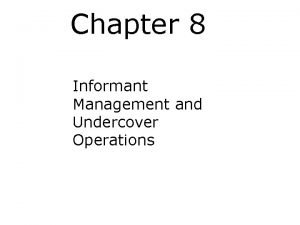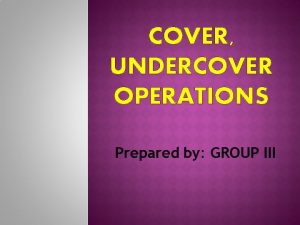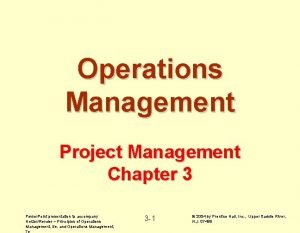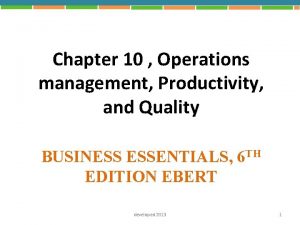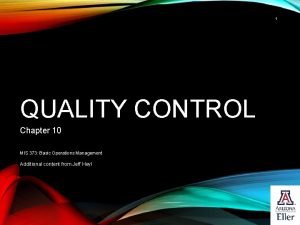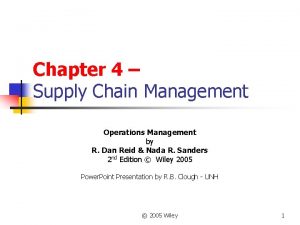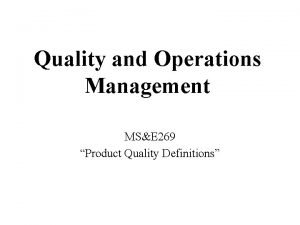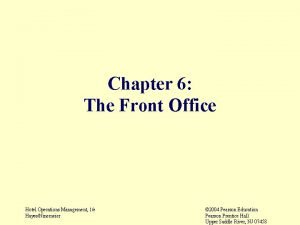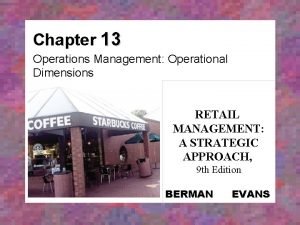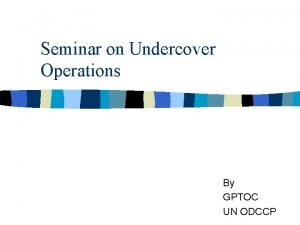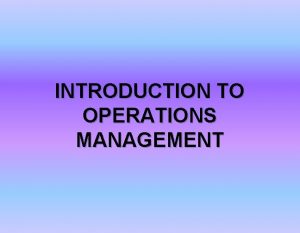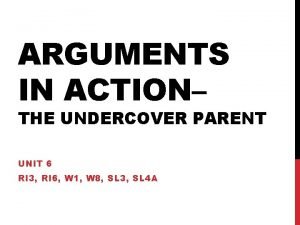Chapter 8 Informant Management and Undercover Operations Chapter

































- Slides: 33

Chapter 8 Informant Management and Undercover Operations

Chapter Objectives 1. Identify informants and their various uses. 2. Explain how to properly document and process an informant. 3. Explain how to maintain control of an informant during an investigation. 4. Summarize the legal framework for informant management. continued on next slide

Chapter Objectives 5. Summarize the usefulness of undercover investigations. 6. Describe the types of undercover operations. 7. Describe the undercover working environment. continued on next slide

Chapter Objectives 8. Explain how to protect the undercover officer's "cover. " 9. Explain methods of infiltration and the risks involved in undercover operations.

Learning Objective 8. 1 Identify informants and their various uses.

Informants and Their Uses • Informant § Anyone who provides information of an investigative nature to law enforcement continued on next slide

Informants and Their Uses • Informants can be: § § Average citizens Fellow law enforcement Mentally ill persons Criminals continued on next slide

Informants and Their Uses • Problems that can stem from use of informants § Difficult to control § Source of public embarrassment § Credibility continued on next slide

Informants and Their Uses • Informant motivations § § § Fearful Financially motivated Revengeful Egotistical Perversely motivated Reformed

Learning Objective 8. 2 Explain how to properly document and process an informant.

Documentation of Informants • Includes: § Fingerprinting and photographing § Careful interview by investigators before use as an informant § Background check

Learning Objective 8. 3 Explain how to maintain control of an informant during an investigation.

Maintaining Control of an Informant • Control of informants best achieved through frequent personal contact with them • Instruction in the area of entrapment § Giving suspect "opportunity" for commission of a crime, not "motivation"

Learning Objective 8. 4 Summarize the legal framework for informant management.

Legal Framework for Informant Management • • Aguilar v. Texas (1964) Harris v. United States (1968) Illinois v. Gates (1983) Alabama v. White (1990)

Learning Objective 8. 5 Summarize the usefulness of undercover investigations.

Undercover Operations • Benefits § Provides considerable information that is not otherwise available through traditional investigative methods § Highly specialized § Not practiced by all law enforcement agencies continued on next slide

Undercover Operations • Concerns § Delicate nature of work § Officer must assume identity and lifestyle immersed in criminal subculture where there is a temptation to do immoral or illegal things. § Claims of entrapment continued on next slide

Elements of an Undercover Operation

Learning Objective 8. 6 Describe the types of undercover operations.

Types of Undercover Operations • Short-term § Safer § Help of surveillance officers and protection not available to deep-cover continued on next slide

Types of Undercover Operations • Deep-cover § Longer term § Allows agent time to gain trust of suspect

Learning Objective 8. 7 Describe the undercover working environment.

Undercover Work Environment • The cover story § Keep it simple. § Should fit with the area and people involved § Place of employment should be difficult to check. § Appearance and mannerisms should fit the cover story.

Learning Objective 8. 8 Explain how to protect the undercover officer's "cover. "

Protecting Undercover Officer's "Cover" • Consistency in cover story § Keep cover story general so most questioning and suspicion can be easily overcome. • Staying calm § Panic is the worst enemy of an undercover officer.

Learning Objective 8. 9 Explain methods of infiltration and the risks involved in undercover operations.

Infiltration • During infiltration, a relationship is established between the officer and a suspect. • Sometimes will require an informant to assist initially § When no informant is used, it may be necessary to canvass a target area. continued on next slide

Infiltration • Risks in undercover assignments § § § Relationship stress Stress from uncertainty Alcohol and drug use Personal guilt Reintegration issues

Chapter Summary • Criminal informants are people who are currently, or have been, associated with a particular criminal element and are in a position to supply information about criminal activity. • All candidates for informants should be fingerprinted, photographed, and interviewed by investigators before being used as an informant. continued on next slide

Chapter Summary • The investigator who develops an informer is the one who is assigned to them. • Informants should be considered "property" of the department and should be sufficiently documented. continued on next slide

Chapter Summary • Undercover operations have been used by police agencies for decades and are an important part of the criminal investigation function that is highly specialized. • Undercover assignments are performed in either the short or long term. continued on next slide

Chapter Summary • A prerequisite for assuming an undercover role is to establish a cover story. • Different criminals use different methods to expose undercover police agents. • Risks are inherent with infiltration.
 Types of undercover assignment
Types of undercover assignment Community health assessment interview questions
Community health assessment interview questions Under cover operation
Under cover operation The undercover parent
The undercover parent Chapter 12 inventory management
Chapter 12 inventory management Operations and quality management
Operations and quality management Operations management with total quality management book
Operations management with total quality management book Operations management chapter 3 solutions
Operations management chapter 3 solutions Operations management chapter 4 forecasting solutions
Operations management chapter 4 forecasting solutions International strategy
International strategy Objectives of operations
Objectives of operations Process selection in operations management
Process selection in operations management Operations management chapter 10
Operations management chapter 10 Asq control chart
Asq control chart Chapter 8 operations management
Chapter 8 operations management Forecasting
Forecasting Crossover chart operations management
Crossover chart operations management Operation management chapter 4
Operation management chapter 4 Chapter 11 operations management
Chapter 11 operations management Job design continuum
Job design continuum Chapter 4 operations management
Chapter 4 operations management Competitive operations strategy
Competitive operations strategy Mse in operations management
Mse in operations management Maintenance and reliability in operations management
Maintenance and reliability in operations management Design of goods and services in operations management pdf
Design of goods and services in operations management pdf Maintenance cost example
Maintenance cost example Introduction to operations and supply chain management
Introduction to operations and supply chain management Gartner it infrastructure and operations management summit,
Gartner it infrastructure and operations management summit, Chapter 7 strategic management
Chapter 7 strategic management Mis issues in strategy implementation
Mis issues in strategy implementation Implementing strategies: management and operations issues
Implementing strategies: management and operations issues Back office department in hotel
Back office department in hotel Distinctive competencies in organizations seldom relate to:
Distinctive competencies in organizations seldom relate to: Retail management and operations
Retail management and operations
